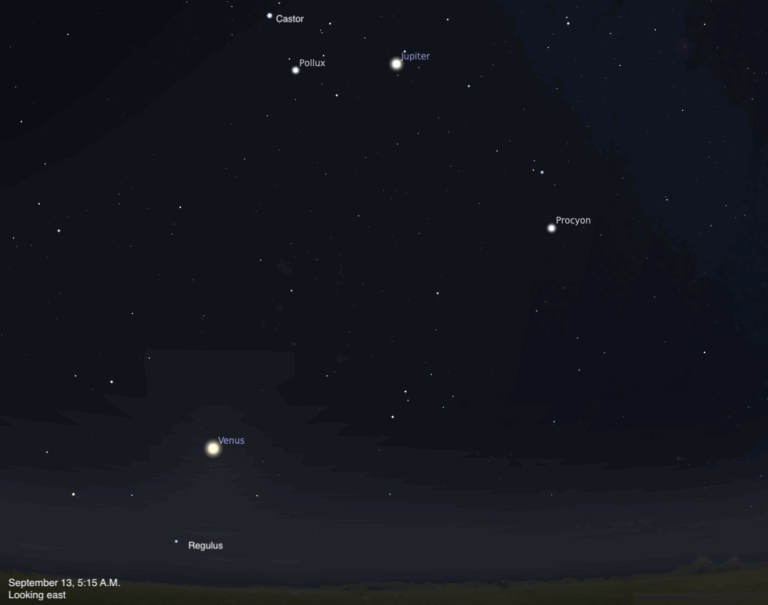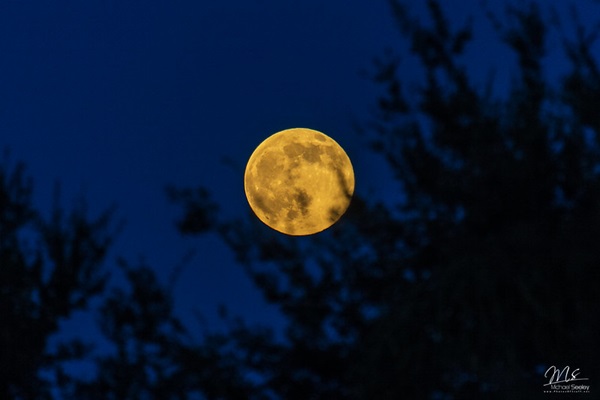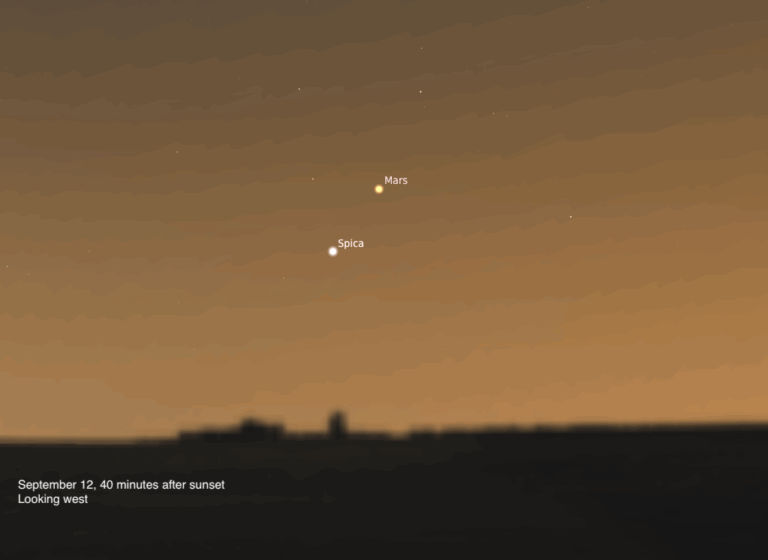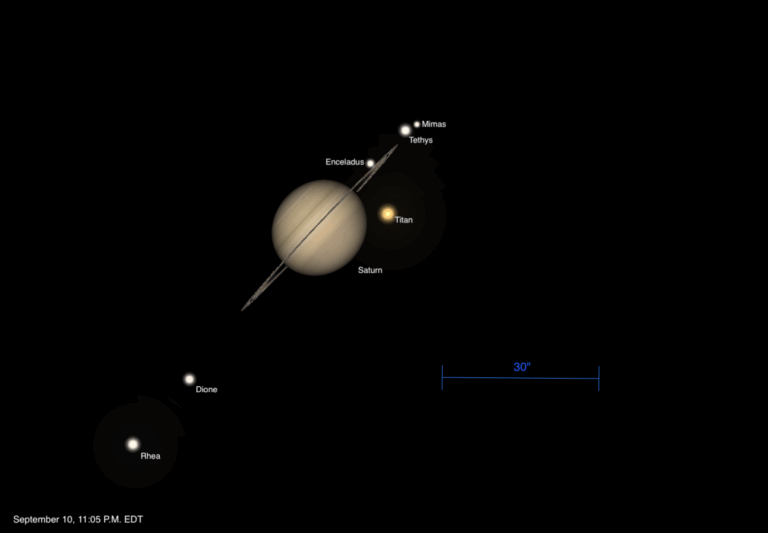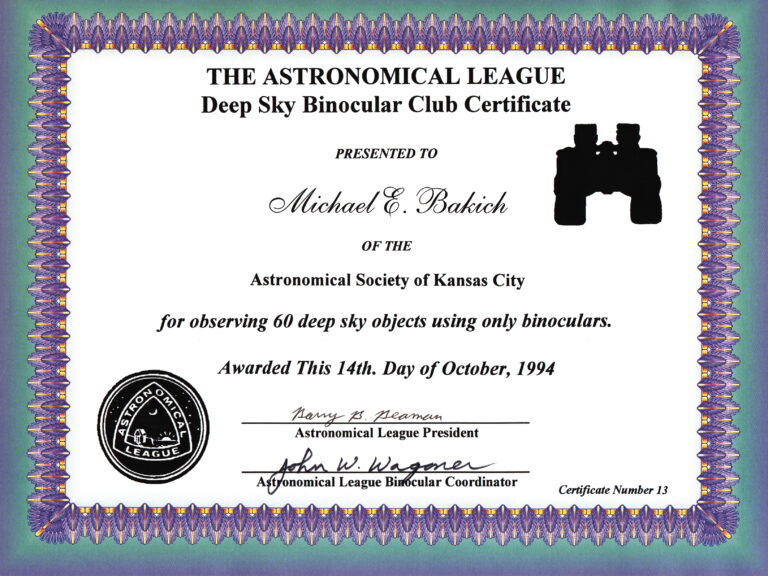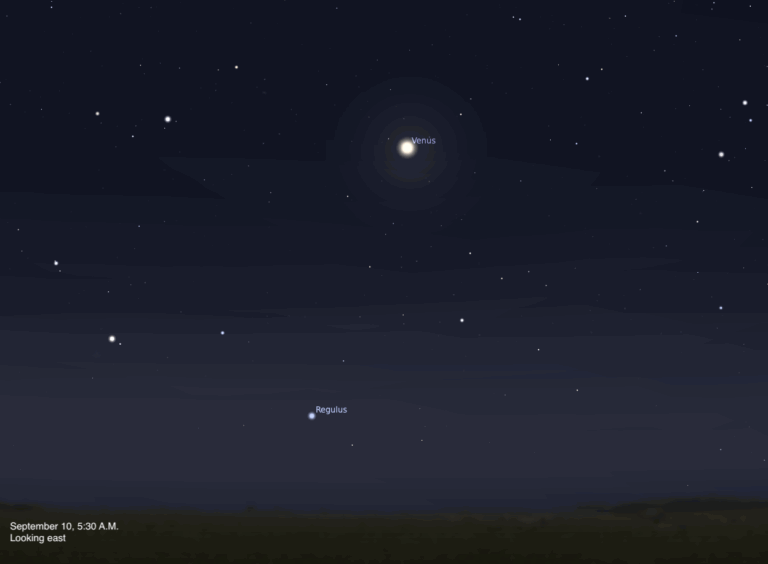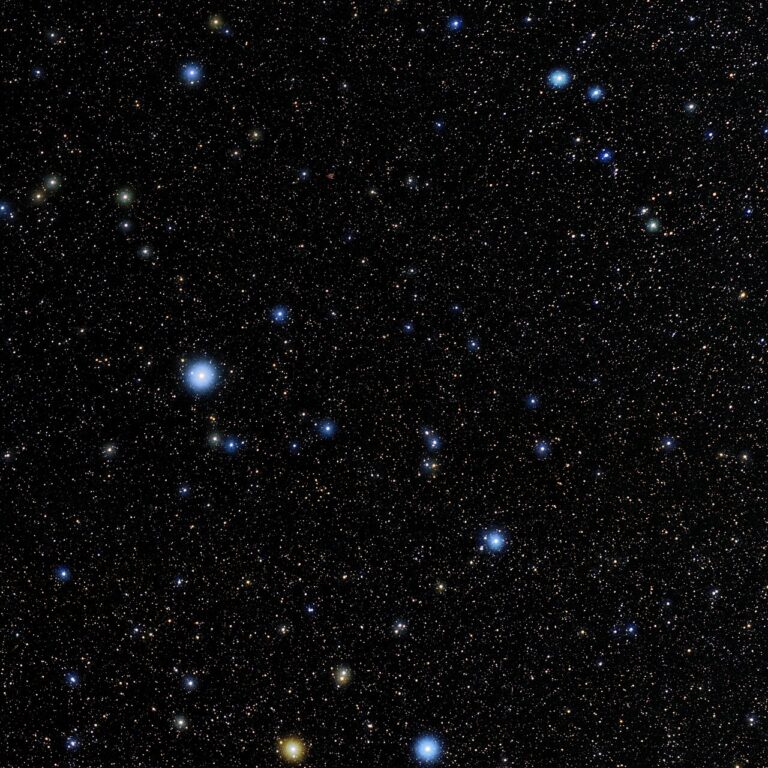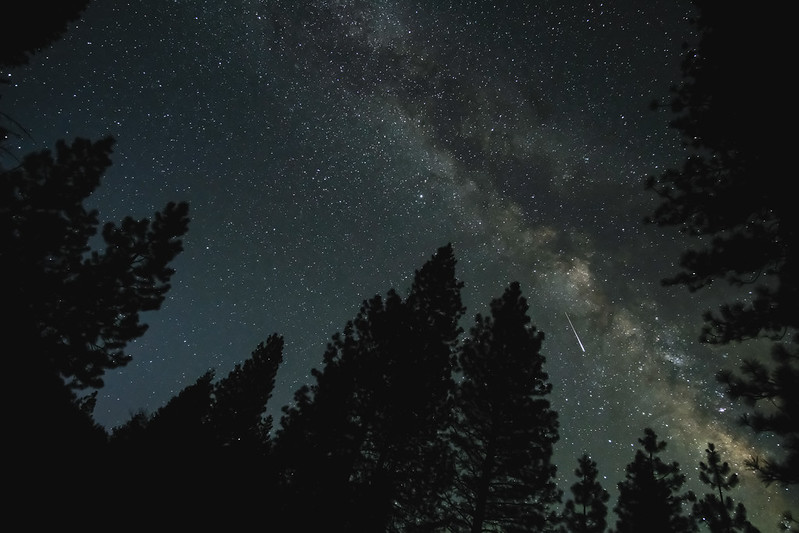
Key Takeaways:
- From April 18-25, Jupiter's visibility in the early evening, along with a transit of Io and its shadow (depending on location), is highlighted, accompanied by the observation of Uranus using binoculars near the Pleiades.
- Comet C/2025 F2 (SWAN) is observable in the early morning before sunrise on April 19, using binoculars or a small telescope, near Mirach in Andromeda.
- Opportunities for deep-sky observation are noted for April 20, focusing on the Virgo Cluster, including M87, and its neighboring galaxies, M84 and M86. April 24 offers viewing of the Pinwheel Galaxy (M101).
- Planetary observations are featured, including Mercury's greatest western elongation on April 21, and Venus and Saturn's visibility in the predawn sky alongside the Moon and Mercury, culminating in a close lunar conjunction with Mercury and Venus on April 25, with an opportunity to observe Neptune.

Sky This Week is brought to you in part by Celestron.
Friday, April 18
Jupiter still rules the early-evening skies, standing prominently in Taurus in the west as darkness falls. Located between the two horns of Taurus the Bull and above its red giant eye, Aldebaran, Jupiter is the brightest point of light in the west, shining at magnitude –2. Far to its lower right is the Pleiades star cluster (M45), an easy naked-eye object, particularly with no moonlight to interfere.
Below the Pleiades is Uranus. At magnitude 5.8, it is an easy binocular object in a dark sky, though you’ll want to look for it in the hour or two after sunset, when it is still relatively high and out of the thicker, more turbulent air near the horizon. To find it, first center your view on the Pleiades, then drop 4.5° south to a pair of stars shining at 6th magnitude. These are 13 and 14 Tauri, with the westernmost star (13 Tau) shining slightly brighter than its partner.
From 13 Tau, it’s just a 2.5° jump southwest to land on Uranus, whose small, 3”-wide disk should appear grayish-blue. It now stands 1° north of a fainter, magnitude 6.8 field star.
Over at Jupiter, observers with a telescope can catch a transit of the Galilean moon Io along with its shadow. How much and what you will see depends on your location. Io begins to cross the planet, starting at the southeastern limb, at 10:35 P.M. EDT. Its shadow transit begins at 10:36 P.M. CDT — note the time change, as Jupiter has set for East Coast observers. Io’s transit ends just before 10:50 P.M. MDT (now Jupiter is setting in the Midwest) and the shadow transit ends around 10:50 P.M. PDT, when Jupiter is only visible in the Pacific time zone.
Meanwhile, Ganymede and Callisto lie west of the planet (Ganymede is closest), with Europa standing east of the gas giant along with Io until the latter’s transit starts.
Sunrise: 6:17 A.M.
Sunset: 7:42 P.M.
Moonrise: 12:43 A.M.
Moonset: 9:23 A.M.
Moon Phase: Waning gibbous (73%)
*Times for sunrise, sunset, moonrise, and moonset are given in local time from 40° N 90° W. The Moon’s illumination is given at 12 P.M. local time from the same location.
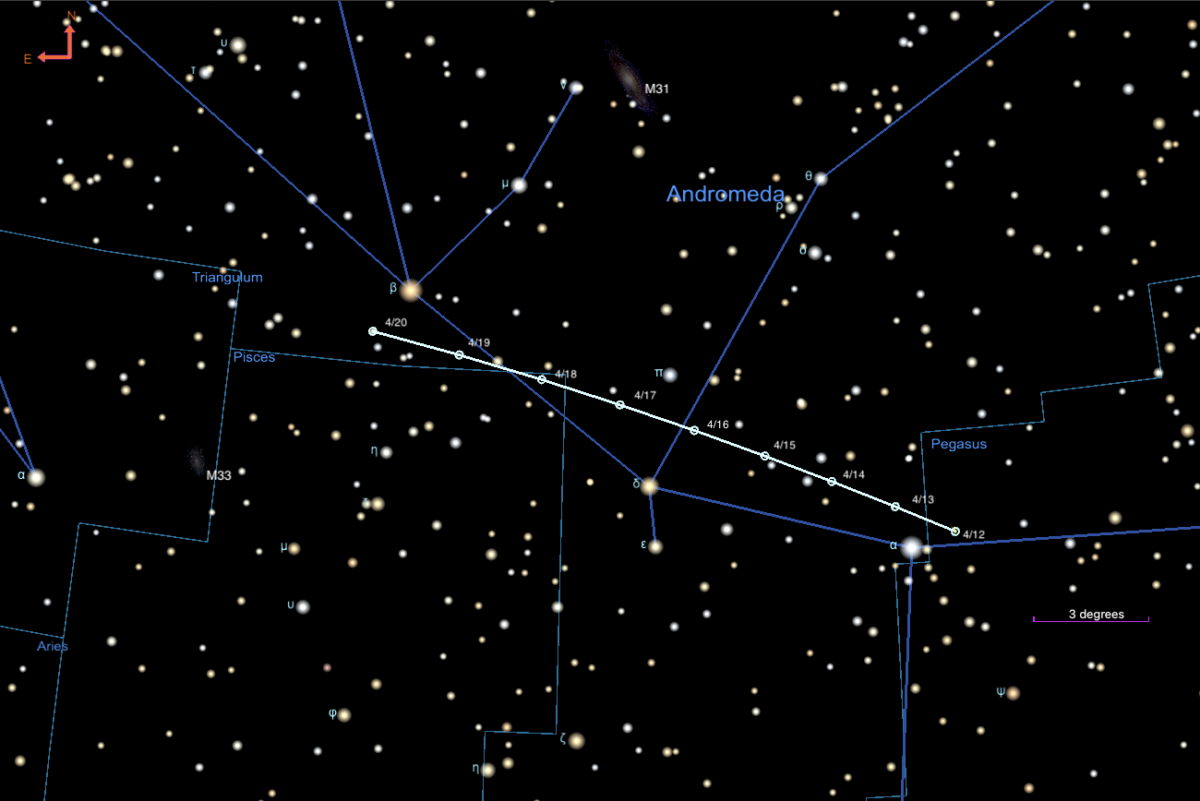
Saturday, April 19
Discovered less than a month ago, Comet C/2025 F2 (SWAN) is holding steady around 8th magnitude, visible in the early-morning sky shortly before sunrise. It is currently skimming through Andromeda and lies in the northeast an hour before sunrise, with the waning Moon still squarely in Sagittarius’ Teapot this morning, over in the south.
The bright star Mirach provides a good guidepost to find the comet over the next few days. Shining at magnitude 2.1, Mirach stands about 12° high in the northeast an hour before sunrise, to the lower left of the Square of Pegasus. This morning, Comet SWAN is just 2° southwest of this star. Tomorrow morning, it will have moved slightly closer — 1.5° from the star — and stand to Mirach’s southeast.
Given its current magnitude, SWAN requires binoculars or a small telescope to see. Its glowing green coma and long tail stand out well in astrophotos, and its proximity to the horizon allows for stunning compositions that combine landscape elements with the predawn sky. Now is the best time to catch it, as the Moon is moving quickly through the sky toward the comet’s position, all while the comet is rising later (i.e., closer to dawn and in a brighter sky) each morning.
Sunrise: 6:16 A.M.
Sunset: 7:43 P.M.
Moonrise: 1:36 A.M.
Moonset: 10:21 A.M.
Moon Phase: Waning gibbous (64%)
Sunday, April 20
Last Quarter Moon occurs this evening at 9:36 P.M. EDT with the Moon in Capricornus; however, our satellite won’t rise until roughly 3 A.M. local daylight time tomorrow morning.
That’s good news for observers who want to focus on deep-sky objects. Also good news: Virgo is climbing in the southeastern sky a few hours after sunset. This constellation is home to the eponymous Virgo Cluster of galaxies, which includes the massive elliptical galaxy M87. Discovered in 1781, this magnitude 8.6 galaxy spans roughly 7’ and is located in northern Virgo, slightly less than halfway along a line starting at Epsilon (ε) Virginis and ending at Beta (β) Leonis in Leo. More specifically, M87 lies 7.8° west of 3rd-magnitude Epsilon and 3.5° northwest of 5th-magnitude Rho (ρ) Vir. This galaxy is home to a 6.5-billion-solar-mass black hole — the first supermassive black hole to be imaged by the Event Horizon Telescope in a photo released in 2019. Dedicated astrophotographers may be able to capture the black hole’s powerful jet, which extends thousands of light years beyond the galaxy, using large scopes and long-exposure photographs.
Because it lies at the heart of a massive galaxy cluster, M87 has many near neighbors on the sky. Two of the most prominent lie roughly 1.3° west-northwest of M87: These are M84 and M86, two more elliptical galaxies separated by just ¼°. M86 glows at magnitude 8.9 and is the easternmost (and slightly brighter) galaxy of this pair, while M84 is just to its west and glows at magnitude 9.1.
If you scan around the general region of these galaxies as well, you’re sure to find more faint smudges representing many members of the Virgo Cluster.
Sunrise: 6:14 A.M.
Sunset: 7:44 P.M.
Moonrise: 2:20 A.M.
Moonset: 11:26 A.M.
Moon Phase: Waning gibbous (54%)
Monday, April 21
The Moon, still in Capricornus, passes 0.7° south of the distant, dim dwarf planet Pluto at 2 A.M. EDT.
Mercury reaches greatest western elongation at 3 P.M. EDT, now 27° from the Sun. It’s visible in the early-morning sky at magnitude 0.4 and rises nearly an hour before the Sun. Roughly half an hour before sunrise, Mercury has reached an altitude of 4° high in the east. Observers who want to catch it should opt for a viewing location free of obstructions along the eastern horizon, as well as a site higher in elevation than the surrounding area if possible.
Most prominent in the predawn sky will be Venus, blazing at magnitude –4.8. Let’s start here — through a telescope, the bright planet’s disk stretches an impressive 43” and shows off a crescent phase some 21 percent lit.
From Venus, drop about 9.9° to the lower left (east) to locate Mercury. The smaller planet appears 8” wide and is nearly half-lit, showing a 45-percent-illuminated crescent.
Also visible is Saturn, although the ringed planet is quite faint at magnitude 1.2. It lies some 4.8° to the lower right (southeast) of Venus) and should be readily visible through binoculars or a telescope. The latter will better show off the planet’s thin rings in the growing twilight.
As always, make sure to put away any binoculars or telescope several minutes before sunrise from your location, which may differ from the time given below.
Sunrise: 6:13 A.M.
Sunset: 7:45 P.M.
Moonrise: 2:58 A.M.
Moonset: 12:36 P.M.
Moon Phase: Waning crescent (43%)
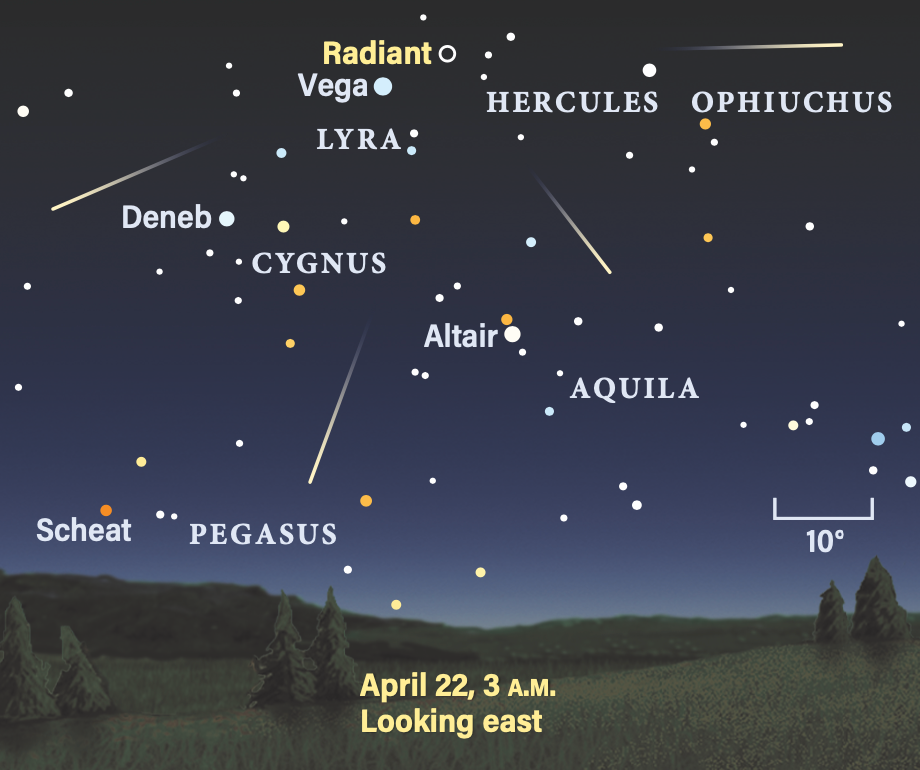
Tuesday, April 22
The Lyrid meteor shower peaks today, with your best views in the early morning starting shortly after midnight and running through the start of twilight.
The shower’s radiant, the point in the sky from which Lyrid meteors appear to originate, is located to the upper right of bright Vega in Lyra the Lyre. Around 3 A.M. local daylight time, you’ll find this bright star some 60° high in the east, forming the apex of the Summer Triangle anchored by Deneb to its lower left and Altair to its lower right.
Once you’ve found Vega, sweep your gaze some 40° to 60° to the right and left of its location — this is where you’ll spot meteors with the longest bright trains as they streak across the sky. The shower is expected to produce about 20 meteors per hour at its best roughly an hour before dawn, with lower rates leading up to this time.
Meteor showers occur when Earth’s orbit carries us through a cloud of debris left by a comet or active asteroid. The Lyrids are associated with Comet C/1861 G1 (Thatcher), which last came close to the Sun in 1861.
Sunrise: 6:11 A.M.
Sunset: 7:46 P.M.
Moonrise: 3:30 A.M.
Moonset: 1:48 P.M.
Moon Phase: Waning crescent (33%)

Wednesday, April 23
The Moon always shows us the same face — mostly. Thanks to a slight offset in its tilt relative to its orbit around our planet, as well as our satellite’s elliptically shaped orbit, the Moon appears to “wobble” over time, revealing slightly more than strictly half its face to us. Called libration, this effect allows us to peek “over” the limbs in some cases — as tonight, when Mare Orientale is visible as an elongated dark feature on the southwestern limb.
Stretching some 185 miles (300 kilometers) across and ringed by mountain ranges that extend its width to nearly 600 miles (965 km), Mare Orientale is an ancient impact basin that, from directly above, appears like a perfect bull’s-eye. Its floor is coated in dark lava and several other smaller lava patches are also visible nearby, such as Lacus Autumni and Lacus Veris.
The waning Moon is visible in the predawn sky, rising around 4 A.M. local daylight time. Compare the view through your telescope eyepiece of its southwestern region to the one shown here for help identifying the features fleetingly visible while the current tilt favors the view.
The Mare Orientale region will be visible again tomorrow morning, and also next month around Third Quarter.
Sunrise: 6:10 A.M.
Sunset: 7:47 P.M.
Moonrise: 3:58 A.M.
Moonset: 3:01 P.M.
Moon Phase: Waning crescent (23%)
Thursday, April 24
After the sky falls dark tonight, look north to find the Big Dipper. Early in the evening, this famous asterism appears upside-down, with its bowl spilling imaginary water down toward the ground.
Find the Dipper’s handle and locate the last two stars: Mizar and Alkaid (the latter is the star at the very end of the handle). Now, pull out your telescope and center it on magnitude 1.9 Alkaid; from here, skim 5.5° northeast to discover M101, also known as the Pinwheel Galaxy or sometimes the Northern Pinwheel Galaxy, to avoid confusion with M33.
Glowing at magnitude 7.8, M101 may seem bright on paper but its details are actually a bit difficult to spot in smaller scopes, as it’s a face-on spiral galaxy that stretches nearly half a degree across. That spreads out the light of its arms, making them a challenge to pick out. However, the galaxy’s compact, bright core should be readily visible in any instrument, including large binoculars. If you do have a big scope and clear, dark skies, push to the limit to see if you can make out this flocculent spiral’s faint, clumpy arms. See also if you can tell that its nucleus is not centrally located within the object, but offset so that the galaxy appears markedly asymmetric.
The Moon passes 2° south of Venus at 9 P.M. EDT, and then moves to pass 2° north of Saturn at midnight EDT. We’ll catch the view in the predawn sky tomorrow morning.
Sunrise: 6:09 A.M.
Sunset: 7:48 P.M.
Moonrise: 4:23 A.M.
Moonset: 4:15 P.M.
Moon Phase: Waning crescent (14%)
Friday, April 25
We’re up early on the last day of the week to view the delicate crescent Moon standing between Mercury and Venus in the morning sky.
Forty minutes before sunrise, Mercury has just cleared the horizon and stands 2° high in the east. It is now a touch brighter than earlier this week, shining at magnitude 0.3. It’s also just moved into a gibbous phase, now 51 percent lit.
Some 12° to Mercury’s upper right is the unmissable magnitude –4.8 Venus. Between the two planets hangs the Moon, some 7° high at this time and 8 percent lit, showing off a thin crescent. You may also see earthshine lighting up our satellite’s darkened face — this is light bouncing off Earth and falling on the Moon, which can illuminate regions that are otherwise hidden by our planet’s shadow. The Moon will pass 4° north of Mercury at 9 P.M. EDT this evening.
To the right of the Moon this morning is 1st-magnitude Saturn, which will be harder to spot the lighter the sky becomes. Neptune also lies close to the Moon — in fact, our satellite passes 1.9° due north of Neptune at 6 A.M. EDT, but the distant world is a challenge to see in the quickly brightening sky. It will require binoculars or a small telescope to spot, as its magnitude is 7.8. While you’ve got your observing gear out, note that you can easily enjoy Saturn with it as well, but make sure to cease observing with any optics well before the Sun peeks over the horizon.
Sunrise: 6:07 A.M.
Sunset: 7:49 P.M.
Moonrise: 4:47 A.M.
Moonset: 5:32 P.M.
Moon Phase: Waning crescent (7%)

